1950 Jewish RARE POSTCARD Children RUSHKEVITZ Israel IDF AIRFORCE PLANE Hebrew
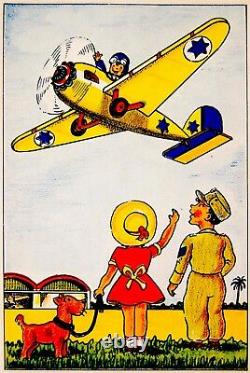
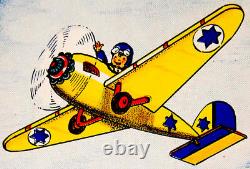
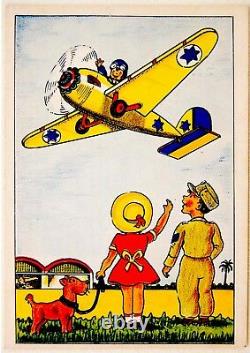
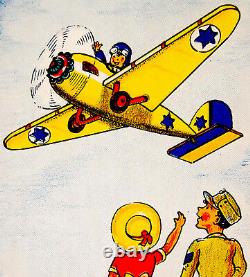
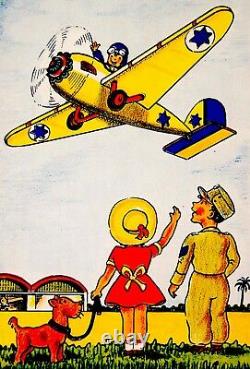
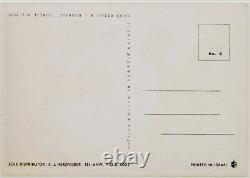



Here for sale is an EXTREMELY RARE over 60 years old Eretz Israeli illustrated POSTCARD, STONE LITHOGRAPH printing, With vibrant COLORS and DESIGN. The POSTCARD was printed in ca early-mid 1950's, Only a few years after the BIRTH of the INDEPENDENT STATE of ISRAEL and its 1948 WAR of INDEPENDENCE. The POSTCARD was DESIGNED and PUBLISHED by perhaps the MOST CONSIDERED graphical ARTIST and ILLUSTRATOR of Childrens' books, Childrens' games, Playing CARDS etc, Whose STONE LITHOGRAPHIC prints are known to be an ARTISTIC MASTER WORK in that artistic field. His name was F RI TZ (Peretz) RUSCHKEWITZ Also Roshkovitz - Rushkevitz. The POSTCARD depicts an ERETZ ISRAELI quite naive militaristic scene of an Eretz Israeli IDF - ZAHAL boy-soldier wearing typical 1940's-1950's IDF uniforms including the typical HITELMACHER CAP - HAT, Standing in an Eretz Israeli AIRFORCE AIRFIELD, Waving to an. Eretz Israeli AIRFORCE BOY-PILOT in his AIRFORCE PLANE, All covered with the typical BLUE DAVID STAR (Also David Shield, David coat of arms) SIGNS-EMBLEMS of the. A sweet Eretz Israeli GIRL with her DOG is accompany the SCENE.
This is indeed a quite RARE postcard. Size around 6 x 4.
Postaly unused (Pls look at scan for accurate AS IS images). Will be sent in a protective rigid sealed packaging.NOT a reproduction or a reprint , It holds a life long GUARANTEE for its AUTHENTICITY and ORIGINALITY. He lived in Tel Aviv and his artistic activity focused on illustrating and publishing books for children. However, he never quite master the Hebrew language and for his books' texts he was assisted by known Israeli writers, most notably Leah Goldberg. His illustrations are still live and beautiful to this very day. The Israeli Air Force was born in to the War of Independence in 1948.
Preceded by "Sherut Avir", the air wing of the Haganah (that was later to become Israeli Defence Force), it was a small group of people and only a few planes. Recruits and aircraft joined the young force bringing in valuable skills, aircraft, and equipment.
On May 29th 1948, the IAF deployed for the first time, and using four Czechoslovakian Messerschmitt planes, helped to bring to a halt an Egyptian advance near the Port city of Ashdod. During the War of Independence, the IAF intercepted enemy air craft, supported ground forces, and went on attack sorties to Cairo, Damascus, and Amman. With the war end, most of the foreign volunteers were released, and the IAF, which now relied on Israeli pilots only, began organizing its air bases, formulate its combat policies and establish new Squadrons which were equipped with new aircraft. In early 1950's the IAF was well organized from an administrative and operational perspectives.
Control systems were developed, and the use of aerial photography became an important source of intelligence. In 1953 the force entered the "Jet Era", when British "Meteor" aircraft joined the force. In 1956 the IAF performed multiple roles in Operation "Kadesh" (The Israeli operation in the Sinai Peninsula); dropping paratroopers over Sinai, destruction of Egyptian communication lines, rescue missions, support of ground forces, and aerial attacks. In the 1960's the IAF continued adopting new aircraft, and its combat policy, strategy, and ability was put to a test in a long row of air clashes against Egypt, Syria and Jordan. At the initial stages of the "Six Day War" the IAF executed a courageous operation "Focus", almost entirely destroying the Egyptian air force, and severely damaging the air forces of Jordan, Syria and Iraq. Gaining aerial superiority, the air force then provided complete support to ground forces. At the "War of Attrition" the air force fought on all fronts. The most intense battles took place in Egyptian frontier: Air battles, attacks on missile batteries in the Suez Canal, and attacks on targets deep in the heart of Egypt.Joint operations with ground forces also took place in Jordan valley, and the Egyptian front. During these years, the air force continued to acquire better and more sophisticated air craft, and in early 1970's it first entered the world of Unmanned Aerial Vehicles (UAV). The "Yom Kippur" War, in 1973 was a big test for the Israeli Air force. From the early hours of the war, IAF aircraft support efforts to halt Egyptian and Syrian advance, engaged in air battles, attacked enemy ground forces, bombed enemy's airports, and attacked strategic targets.
The greatest threat to IAF was the Ground-Air missiles array. A large number of planes were intercepted and shot down. A great deal of effort was spent in the post-war years, to tackle this challenge, and minimize its threat. In July 1976, Operation "Entebbe" led to the safe return of Israeli hostages from the plane kidnapped in Athens, and then brought to Uganda. IAF's Hercules planes transported the forces and their equipment to Uganda, who then return to Israel with the hostages. In 1978 air force planes supported operation "Litani". In June 1981 IAF jets destroyed the nuclear reactor in Iraq. A year later, the force attacked strategic targets during the first Lebanon war, and engaged in aerial battles, taking down around 100 Syrian planes. In operation "Mole Cricket 19" Israeli jets destroyed the Syrian anti-aircraft missile batteries in Lebanon. In the 1980's the air force assisted with the mass repatriation of Ethiopian Jews to Israel.In October 1985 the IAF attacked the most remote target - The P. O command center in Tunisia in operation "wooden Leg". In the first years of the 21st century, the IAF was heavily involved in various operations in Yehuda, Shomron, and Gaza, destroying strategic terrorist targets, and intelligence missions, especially since the unilateral withdrawal from Gaza strip in 2005. At the Second Lebanon War in summer 2006, the IAF destroyed rocket launch pads, terrorist infrastructure, provided support to ground forces, evacuated injured soldiers, gathered intelligence, and transported forces deep into Lebanon's territory.
Operation "Cast Led" in December 2008 launched with a broad aerial attack on "Hamas" infrastructure in the Gaza strip. Throughout the operation the IAF provided ongoing support to ground forces, gathered intelligence, evacuated the wounded, and handled the terrorist rocket launch pads. The Israeli Air Force IAF; Hebrew:???? Zroa HaAvir VeHahalal, "Air and Space Arm", commonly known as???
Heyl HaAvir, "Air Corps" is the air force of the Israel Defense Forces. It was founded at the same time as the formation of the State of Israel. At first, it was assembled from a hodge-podge collection of civilian aircraft commandeered or donated and converted to military use. A variety of obsolete and surplus ex-World War II combat aircraft were quickly sourced by various means to supplement this fleet. Creativity and resourcefulness were the early foundations of Israeli military success in the air, rather than technology (which, at the inception of the IAF, was generally inferior to that used by Israel's adversaries). Many of the first IAF's pilots in 1948 were foreign volunteers (both Jewish and non-Jewish) and World War II veterans, who wanted to collaborate with Israel's struggle for its independence. The IAF's humble beginnings made its first air victories particularly impressive and noteworthy. Israel's new fighter arm first went into action on May 29, 1948, assisting the efforts to halt the Egyptian advance from Gaza northwards. Four newly arrived Avia S-199s, flown by Lou Lenart, Modi Alon, Ezer Weizman and Eddie Cohen, struck Egyptian forces near Isdud. Although damage was minimal, two aircraft were lost and Cohen killed, the attack nevertheless achieved its goal and the Egyptians stopped. The Avias were back in action on May 30, attacking Jordanian forces near Tulkarem, losing another aircraft in the process. The Israeli Air Force scored its first aerial victories on June 3, when Modi Alon, flying Avia D. 112, shot down a pair of Egyptian Air Force DC-3s which had just bombed Tel Aviv. The first dogfight against enemy fighters took place a few days later, on June 8, when Gideon Lichtaman shot down an Egyptian Spitfire. [1] As the war progressed, more and more aircraft were procured, including Boeing B-17s, Bristol Beaufighters, de Havilland Mosquitoes and P-51D Mustangs, leading to a shift in the balance of power. By the end of the war in early 1949, the IAF had secured air supremacy over Israel, [2] one that has not been seriously challenged since. The Israeli Air Force played an important part in Operation Kadesh, Israel's part in the 1956 Suez Crisis. At the launch of the operation, on October 29, Israeli P-51D Mustangs severed telephone lines in the Sinai, some using their propellor blades[2], while 16 IAF DC-3s escorted by fighters dropped Israeli paratroopers behind Egyptian lines at the Mitla Pass and Et-Tur.During the 1950s, France became a major supplier of warplanes to Israel, but relations between the two countries deteriorated just before the Six-Day War, when France declared an arms embargo on Israel. Consequently, Israel Aircraft Industries (IAI) significantly increased its aircraft and weapons production (initially based on the French models) and Israel switched to the United States as its principal supplier of military aircraft. The Six-Day War Main article: Six-Day War In three hours on the morning of June 5, 1967, the first day of the Six Day War, the Israeli Air Force executed Operation Focus, crippling the opposing Arab air forces and attaining air supremacy for the remainder of the war.
In a surprise attack, the IAF destroyed most of the Egyptian Air Force while its planes were still on the ground. By the end of the day, with surrounding Arab countries also drawn into the fighting, the IAF had mauled the Syrian and Jordanian air forces as well, striking as far as Iraq. After six days of fighting Israel claimed a total of 452 Arab aircraft destroyed, of which 49 were aerial victories. The War of Attrition Main article: War of Attrition Shortly after the end of the Six-Day War, Egypt initiated the War of Attrition, hoping to prevent Israel from consolidating its hold over the lands captured in 1967. Israel's goal in the fighting was to exact heavy losses on the opposing side, in order to facilitate a ceasefire.
The Israeli Air Force consequently undertook repeated bombings of strategic targets deep within enemy territory and repeatedly challenged Arab air forces for aerial supremacy, all the while supporting operations by Israel's ground and naval forces. On July 30, 1970, the tension peaked: An IAF ambush resulted in a large scale air brawl between IAF planes and MiGs flown by Soviet pilots - five MiGs were shot down, while the IAF suffered no losses. Fear of further escalation and superpower involvement brought the war to a conclusion. By its end of August 1970, the Israeli Air Force had claimed 111 aerial kills while admitting losing only four aircraft to Arab fighters.
Notable operations of the War of Attrition include: Operation Rooster 53 - September 26, 1969: IAF Super Frelon and Sikorsky CH-53 Yas'ur helicopters carry paratroopers in a raid to capture an advanced Soviet P-12 radar deployed in Egypt near Suez. A CH-53 helicopter carried the 4-ton radar back to Israeli held territory, tethered underneath it. Operation Priha (Blossom) - January 7, 1970 - April 13 1970: a concentrated series of strikes against military targets in the Egyptian heartland. Rimon 20 - July 30, 1970: the IAF ambushes and shoots down 5 Soviet MiG-21 fighters. Yom Kippur War Main article: Yom Kippur War During the Yom Kippur War of October 1973, the Israeli Air Force shot down 277 enemy warplanes, accounting for over a third of the IAF's total kills since 1948, but at the price of 53 pilots and over 100 of its own aircraft (104 according to Israel, 180-200 according to some western sources, 280 according to Soviet estimates[3]).
The IAF suffered heavy losses mainly due to the introduction of new Soviet air defense equipment and doctrine: medium range SA-6 mobile SAM batteries and point defence provided by short range Shilka radar guided SPAAG and SA-7 Strela MANPADS (employed by Egyptian infantry), advancing with the mechanized forces and covered by older but longer range and still very dangerous SA-2 and SA-3 anti aircraft missile batteries. Nevertheless, throughout the war, the IAF managed to assist IDF ground forces, and kept up strikes on targets in Syria and Egypt. One of the first encounters of the war was the Ofira Air Battle, involving two Israeli Phantoms versus 28 Egyptian Mig-17s and Mig-21s, and resulting in 7 downed Egyptian planes and disengagement of the rest. On October 9, 1973, two F-4 Phantom quartets attacked and destroyed the Syrian General Staff Headquarters in the heart of Damascus, damaging Syrian Air Force Headquarters as well.
During the war, IAF helicopters proved to be highly useful in the logistic and MedEvac roles. Growth (1973-82) Ever since the Yom Kippur War, most of Israel's military aircraft have been obtained from the United States. Among these are the F-4 Phantom II, A-4 Skyhawk, F-15 Eagle, F-16 Fighting Falcon, and E-2 Hawkeye. The Israeli Air Force has also operated a number of domestically-produced types such as the IAI Nesher, and later, the more advanced IAI Kfir, which were unauthorised derivatives of the French Dassault Mirage 5 (Israel bought 50 Mirage 5's from Dassault Aviation, but these were not delivered due to the French embargo emposed following the Six Day war).The Kfir was adapted to utilize a more powerful US engine, produced under license in Israel. In 1976, IAF C-130 Hercules aircraft participated in Operation Thunderball, the rescue from Entebbe, Uganda, of the hostages of Air France flight 139. Bombing of the Iraqi nuclear reactor Main article: Operation Opera On June 7, 1981 eight IAF F-16A fighters covered by six F-15A jets carried out Operation Opera (also referred to as Operation Babylon or Operation Ofra) to destroy the Iraqi nuclear facilities of Osiraq.
Among the pilots that took part in the attack was the late Colonel Ilan Ramon, Israel's first astronaut. 1982 Lebanon War and its aftermath Main article: 1982 Lebanon War Prior to the 1982 Lebanon War, Syria, with the help of the Soviet Union, had built up an overlapping network of surface-to-air missiles in Lebanon's Beqaa Valley. On June 9, 1982 the Israeli Air Force carried out Operation Mole Cricket 19, crippling the Syrian air defence array.
In subsequent aerial battles against the Syrian Air Force, the IAF managed to shoot down 80 Syrian aircraft without losing a single fighter plane in an air to air combat. IAF AH-1 Cobra helicopter gunships destroyed dozens of Syrian armored fighting vehicles and other ground targets, including some T-72 main battle tanks. In 1986 an IAF F-4 Phantom, piloted by Captain Aharon Achiaz, was inadvertently damaged midair and abandoned, resulting in the capture of flight navigator then-Captain Ron Arad by the Lebanese Shi'ite militia Amal. To this day, the whereabouts of Arad has not been disclosed by his captors. For many years after the war's official end, and throughout Israel presence in Lebanon, IAF AH-1 Cobras continued to mount attacks on Hezbollah and PLO positions in south Lebanon.
Bombing of the PLO headquarters in Tunis On October 1 1985, In response to a PLO terrorist attack which murdered three Israeli civilians in Cyprus, the Israeli air force carried out Operation Wooden Leg. The strike involved the bombing of PLO Headquarters in Tunis, Tunisia, by F-15 Eagles. This was the longest combat mission ever undertaken by the IAF, a stretch of 2,300 kilometers, involving in-flight refueling by an IAF Boeing 707.
As a result, PLO headquarters and barracks were either destroyed or damaged. High Tech age (1990 and beyond) Many of the IAF's electronics and weapons systems are developed and built in Israel by Israel Military Industries, Israel Aerospace Industries, Elbit and others. Since the 1990s, the IAF has upgraded most of its aircraft with advanced Israeli-made systems, improving their performances. In 1990 the IAF began receiving the AH-64 Apache helicopter gunship and started equipping its aircraft with the Rafael Python 4, Popeye and Derby missiles.During the first Gulf War of 1991, Israel was attacked by Iraqi Scud missiles. Israeli Air Force pilots were on constant stand-by in their cockpits throughout the conflict, ready to fly to Iraq to retaliate. Diplomatic pressure as well as denial of IFF (Identify Foe or Friend) transponder codes from the United States, however, kept the IAF grounded while Coalition air assets and Patriot missile batteries supplied by the U. And the Netherlands sought to deal with the Scuds. In 1991, the IAF carried out Operation Solomon which brought Ethiopian Jews to Israel.
The first of 102 F-16I Sufas arrived in April, 2004, joining an F-16 fleet that had already been the largest outside the US Air Force. In 2005 the Israeli Air Force received modified Gulfstream V jets ("Nachshon"), equipped with advanced intelligence systems made by Israel Military Industries.
The Israeli Air Force took an extensive part in IDF operations during the al-Aqsa Intifada, including the controversial targeted killings of Palestinian militant leaders, most notably Salah Shakhade, Mahmoud Abu-Hunud, Abu Ali Mustafa, Ahmed Yassin, Adnan al-Ghoul, Jamal Abu Samhadana and Abed al-Aziz Rantissi. While this policy is criticized due to the collateral damage caused in certain instances, Israel claims it is vital in its fight against terrorism and that IAF pilots do whatever they can to avoid civilian casualties, including aborting strikes. 2006 Lebanon War Main article: 2006 Lebanon War The IAF played a critical role in the 2006 Lebanon War by leading the Israeli attacks on Lebanon. These strikes - mainly, though not exclusively, in southern Lebanon - were aimed at stopping rocket launches by Hezbollah's militia targeting Israeli towns. The IAF flew more than 12,000 combat missions during this war.
The most notable mission, taking place during the second day of the war, resulted in the IAF destroying 59 Iranian-supplied medium- and long-range missile launchers in just 34 minutes[4]. Widespread condemnation followed the July 30 IAF airstrike on a building suspected to be a militant hideout near the village of Qana, in which 28 civilians were killed. Hezbollah shot down an IAF CH-53 Yas'ur helicopter on the last day of the war, killing four male and one female aircrew members. Earlier, an IAF F-16I had crashed during take-off. Israeli aircraft also shot down three Iranian[5] aerial drones during the conflict.
[6] Recent activities and Gaza War Main articles: Operation Orchard, Gaza War, and 2009 Sudan airstrikes In September 2007, the Israeli Air Force successfully bombed an alleged Syrian nuclear reactor in Operation Orchard. According to a CBS news report, in January 2009 Israeli planes struck a convoy of trucks in Sudan that was headed for Egypt and carrying weapons apparently meant for the Gaza Strip.
17 trucks had been bombed and 39 smugglers had been killed in the strike. [7] Pilot selection and training Thirty nine Israeli pilots have been credited with ace status, having shot down at least 5 enemy aircraft. Of these, 10 have shot down at least eight jet planes. The top ranking Israeli ace is Colonel Giora Epstein, who shot down seventeen enemy planes.
Epstein holds the world record for jet aircraft shot down, and the most aircraft of any type shot down since the Korean War. The selection process for IAF pilots can be traced to Ezer Weizman, widely considered the architect of the modern Israeli Air Force, and his aim of recruiting only the best for pilots. His reasoning was that the skill and bravery of the ground forces would be for naught if they could be attacked at will from the air. As a result, only those thought to possess the innate ability to succeed as Israeli pilots are even invited to begin the training process, and only the most qualified succeed in completing what is seen by many as the world's most demanding military selection course.Consequently, potential Israeli pilots are identified prior to reporting for national service at age 18, based on factors such as high grades in school and top scores on standardized tests, excellent physical condition and high technical aptitude. Those who meet these and other criteria are invited to participate in a six-day gibush (cohesion), a selection phase involving physical, mental, and sociometric challenges. Recruits are screened not only for their ability to perform the tasks assigned, but for their attitude in performing them -such as how they take hardships and unexpected difficulties, how well they work in groups and how they approach problem solving and disaster management situations. As many as 50% percent of those who commence the gibush will be dropped from further consideration at its conclusion. Those who pass the gibush embark on a three-year journey to earn their wings, which includes extensive flight training, infantry training, an officer's course, and studies towards an academic degree a B.
The prospective pilots are evaluated constantly, and the vast majority of those who begin flight training do not make it through the full program. Those expelled from the course will either remain in the air force in a non-flying capacity, or transfer to an army unit. This depends to a large degree on the stage at which they leave the course. While in flying school, future pilots are sorted and assigned to train on different types of aircraft.
Few become fighter pilots (considered by many to be the most desirable assignment), while the remainder learn to fly helicopters, transport aircraft, or train as navigators. [8] After a landmark 1994 High Court appeal by a Jewish immigrant from South Africa, Alice Miller, the Air Force was instructed to open its flight school to women. Miller passed her entrance exams, yet failed the medical tests and thus did not qualify[9].The first female fighter pilot successfully received her wings in 2001 (several female navigators graduated before her). While Israeli Arabs may volunteer to serve in the IDF, it is unclear whether they can seek air force training.
In 2006, an Israeli Arab applied to be considered for the pilot program, but was not accepted. [10] Units and structure Main article: List of Israeli Air Force aircraft squadrons Air and Space Arm Chief of Arm Staff Group Fixed Wing Air Group Helicopter Air Group Intelligence Group Equipment Group Manpower Group Air Defence Command Unit Control Command Special Air Forces Command Shaldag - air force commando unit Unit 669 - medevac extraction unitChief Medical Officer CommandRamat David Airbase (1st Air-Wing) 109th Squadron ("The Valley Squadron") - operating F-16D 110th Squadron ("The Knights of North Squadron") - operating F-16C 117th Squadron ("The 1st Jet Squadron") - operating F-16C 193rd Squadron ("The Defenders of the West Squadron") - operating Eurocopter Panther (Joint Command with the navy)Sdot Micha (2nd Air-Wing) 150th Squadron of ICBM missiles 199th Squadron of ICBM missiles 248th Squadron of ICBM missiles Hatzor Airbase (4th Air-Wing) 101st Squadron ("The 1st Combat Squadron") - operating F-16C 105th Squadron ("The Scorpion Squadron") - operating F-16D Hatzerim Airbase (6th Airbase) 69th Squadron ("The Hammers Squadron") - operating F-15I 102nd Squadron ("The Flying Tiger Squadron") - operating TA-4 and various trainer aircraft (Flight Training School) IAF Aerobatic Team 107th Squadron ("The Knights of the Orange Tail Squadron") - operating F-16I 123rd Squadron ("The Desert Birds Squadron") - operating S-70 Air Force Infantry School (Air Force Installation Protection Units) Tel Nof Airbase (8th Airbase) 106th Squadron ("The Head of the Spear Squadron") operating F-15B/C/D 114th Squadron ("The Night Guides Squadron") - operating CH-53 118th Squadron ("The Nocturnal Birds of Prey Squadron") - operating CH-53 133rd Squadron ("The Twin-Tail Knights Squadron") - operating F-15A/B/D 210th Squadron - operating Eitan UAVs (Forming[11]) 601st Squadron (Flight Test Center) Uvda Airbase (10th Airbase) 115th Squadron ("The Flying Dragon Squadron") operating F-16A, AH-1, and more - Opposing forces emulation squadron Aviation School IAF Officers School Sde Dov Airbase (15th Air-Wing) 100th Squadron ("The Flying Camel Squadron") - operating Beechcraft King Air 135th Squadron ("The Kings of the Air Squadron") - operating Beechcraft King Air and Beechcraft Bonanza Haifa Airbase (21st Airbase) Technical School IAF Technological College Ramon Airbase (25th Air-Wing) 113th Squadron ("The Hornet Squadron") - operating AH-64D 119th Squadron ("The Bat Squadron") - operating F-16I 190th Squadron ("The Magic Touch Squadron) - operating AH-64 201st Squadron ("The One Squadron") - operating F-16I 253rd Squadron ("The Negev Squadron") - operating F-16I Nevatim Airbase (28th Airbase) 103rd Squadron ("The Elephants Squadron") - operating C-130 116th Squadron ("The Defenders of the South Squadron") - operating F-16A/B120th Squadron ("The Desert Giants Squadron") - operating Boeing 707 122nd Squadron ("The Nahshon Squadron") - operating Gulfstream G550 131st Squadron ("The Knights of the Yellow Bird") - operating C-130 140th Squadron ("The Golden Eagle") - operating F-16A/BPalmachim Airbase (30th Airbase) 124th Squadron ("The Rolling Sword Squadron") - operating S-70 151st Squadron (Missile Testing Squadron)160th Squadron ("The 1st Helicopter Gunships Squadron") - operating AH-1 166th Squadron ("The UAV Squadron") - operating Hermes 450 UAVs 200th Squadron ("The 1st UAV Squadron") - operating Heron UAVsMachanaim Airbase (reserve) Reserve squadrons: 125th Squadron ("The Light Choppers Squadron") - former operator of Bell-206144th Squadron ("The Phoenix Squadron") - former operator of F-16A/B 147th Squadron ("The Goring Ram Squadron") - former operator of A-4 149th Squadron ("The Crushing Parrot Squadron") - former operator of Kfir 161st Squadron ("The Northern Cobras Squadron") - former operator of AH-1 192nd Squadron ("The Hawk Eye Squadron") - former operator of E-2 254th Squadron ("The Midland Squadron) - former operator of Kfir Three IAF squadrons (150 Sqn, 199 Sqn and 248 Sqn), based at Sdot Micha, are thought to be responsible for Israel's surface-to-surface nuclear strike capability, maintaining a stockpile of between 50 and 100 Jericho II missiles. During 2008 Israel launched a programme to extend the range of its existing Jericho II ground attack missiles. [12] The Jericho-II missile is capable of sending a one ton nuclear payload 5,000 kilometers. [13] The range of Israels' Jericho II missiles is reportedly capable of being modified to carry nuclear warhead no heavier than 500 kg over 7,800 km, in effect making it an ICBM. [14] Some of the Jericho II missiles are based at facilities which were built in the 1980s. The Jericho III ICBM, became operational in January 2008 [12][16] and some reports speculate that the missile may be able to carry MIRVed warheads.[20] In January 2008 Israel has carried out the successful test launch of a long-range, ballistic missile capable of carrying a nuclear warhead from the reported launch site at the Palmachim air base south of Tel Aviv. [21] Israeli radio identified the missile as a Jericho III and the Hebrew YNet news Web site quoted unnamed defence officials as saying the test had been "dramatic"[22][23] and that the new missile can reach "extremely long distances, " without elaborating. Soon after the successful test launch, Yitzhak Ben Yisrael, a retired army general and Tel Aviv University professor who is now an MP, told Israeli Channel 2 TV: "Everybody can do the math and understand that the significance is that we can reach with a rocket engine to every point in the world"[25] List of IAF Commanders Yisrael Amir (May 1948 - July 1948) Aharon Remez (July 1948 - December 1950) Shlomo Shamir (December 1950 - August 1951) Haim Laskov (August 1951 - May 1953) Dan Tolkovsky (May 1953 - July 1958) Ezer Weizman (July 1958 - April 1966) Mordechai Hod (April 1966 - May 1973) Binyamin Peled (May 1973 - October 1977) David Ivri (October 1977 - December 1982) Amos Lapidot (December 1982 - September 1987) Avihu Ben-Nun (September 1987 - January 1992) Herzl Bodinger (January 1992 - July 1996) Eitan Ben Eliyahu (July 1996 - April 2000) Dan Halutz (April 2000 - April 2004) Elyezer Shkedy (April 2004 - May 2008) Ido Nehoshtan (May 2008 -) Missiles, bombs and satellites Air-to-air missiles AIM-7 Sparrow : Medium-range air-to-air missile. AIM-9 Sidewinder : Short-range air-to-air missile.
AIM-120 AMRAAM : Medium-range air-to-air missile. Shafrir : Obsolete short-range air-to-air missile, no longer in service with the Israeli Air Force. Matra R530 : Obsolete short-range air-to-air missile from the 1960s, no longer in service with the Israeli Air Force. Air-to-ground missiles AGM-62 Walleye : Air-to-surface missile.AGM-45 Shrike : Air-to-surface, anti-radiation missile. AGM-78 Standard : Air-to-surface, anti-radiation missile. AGM-114 Hellfire : Air-to-surface, anti-tank missile. AGM-142 Popeye : Air-to-surface missile Delilah : Air-to-surface missile.
11 : Obsolete air-to-surface missile from the 1950s and 60s, no longer in service with Israeli Air Force. 30 : Obsolete air-to-surface missile from the 1960s, no longer in service with the Israeli Air Force. BGM-71 TOW : Air-to-surface, anti-tank missile.
Bombs GBU-12 - GBU-15 - GBU-16 - GBU-27 - GBU-28 - GBU-31 - GBU-32 - GBU-39 - BLU-109 Guidance kits : JDAM - Spice Surface-to-air missiles Arrow : Anti-ballistic missile system. FIM-92 Stinger : Man portable surface-to-air missile.
MIM-23 Hawk : Medium-range surface-to-air missile. Iron Dome : Anti-rocket & mortar defense missile Surface-to-surface missiles Delilah : Surface-to-surface cruise missile. Jericho I: 500km range Short Range Ballistic Missile[38] Jericho II: 2,800km range Intermediate Range Ballistic Missile[39] Jericho III: 5,000-11,000km range Intercontinental Ballistic Missile[40] Space Systems Amos (1, 2, 3) - communications satellite EROS (A, B) - earth observation satellite Ofeq (3, 5, 7, 9) - reconnaissance satellite TecSAR - reconnaissance satellite Shavit - space launch vehicle. This item is in the category "Collectibles\Religion & Spirituality\Judaism\Images". The seller is "judaica-bookstore" and is located in this country: IL. This item can be shipped worldwide.- Country of Manufacture: Israel
- Country/Region of Manufacture: Israel
- Religion: Judaism


